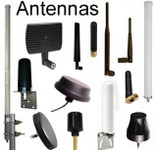Antennas, Antenna Cables, Wireless Products: Technical Articles
Beamforming: How Modern Antenna Arrays Improve Connectivity
Table of Contents
- Beamforming
- A brief introduction to beamforming
- How beamforming works
- Mathematical basis of beamforming
- Types of beamforming
- Beamforming in emerging technologies
- Applications in modern wireless communication
- Potential implications of beamforming and future developments
- Challenges and future of beamforming
- Future advancements
- Conclusion
- FAQs
Beamforming
Wireless communication has developed significantly in recent years, as technologies like 5G, Wi-Fi and cellular antennas in general have pushed the boundaries of connectivity further than ever before. One of the key factors driving these improvements has been beamforming - a technique that optimizes signal transmission to optimize performance, efficiency and reliability.
This article explores the fundamentals of beamforming in modern antenna arrays and its real-world applications in wireless communication. As we progress, we will help your understanding of beamforming’s role and how it is shaping the future of connectivity.

A brief introduction to beamforming
For the uninitiated, let’s clarify what beamforming is and how it is used. Beamforming is a signal-processing technique used in modern wireless communication for its benefits in enhancing signal strength, reducing interference and optimizing network performance. It allows antenna arrays to focus signal transmission and reception in specific directions, instead of broadcasting signals in every direction regardless. This has made beamforming a crucial technology, enabling more efficient and higher-capacity networks.
In today’s wireless world, where high speeds of connectivity are a non-negotiable requirement, beamforming plays a key role in boosting antenna gain, increasing spectral effectiveness, and widening coverage. By adjusting signal direction in a targeted way, beamforming is an enhancement for overall performance of wireless networks and assuring its place as an integral aspect of modern antenna arrays.
How beamforming works
At its core, beamforming relies on an array of antennas working in collaboration to control the direction of transmitted and received signals. Rather than radiate signals uniformly, beamforming takes the approach of modifying the phase and amplitude of each antenna element to create a kind of constructive interference in the direction of choice, and destructive interference in others.
Key concepts in beamforming
Antenna Arrays: Multiple antennas work together to shape the coverage of radio waves.
Constructive Interference: Signals combine to strengthen in a dynamic way, targeting a specific direction.
Destructive Interference: Signals are canceled out in unwanted directions, minimizing interference.
To illustrate this idea, in an array of antennas, each antenna element transmits the same signal at slightly different times (or, more technically, phases). These variations cause the waves to reinforce each other in some directions, while canceling out in others, allowing for specific and precise control over signal directionality.
As a real-world analogy, think of beamforming as a flashlight beam compared to a lantern. While a lantern emits light in all directions - like traditional broadcasting does - a flashlight will emit it in a single direction. This means less diffusion, greater focus, and a more efficient delivery of light, and at the same time means that there is less light pollution in the surrounding area - or, put another way, less harmful interference.
This process is essential for improving coverage, increasing capacity, and reducing loss in cellular antennas and 5G networks. It also plays a considerable tole in Wi-Fi technology, where Wi-Fi antennas use beamforming to provide better connectivity to domestic and business customers.
Mathematical basis of beamforming
To drill down into the underlying technical details, beamforming is based on phased array principles, where multiple antenna elements adjust the phase and amplitude of signals to direct them in a specific way. The core idea is that by slightly delaying signals aimed at different antennas, they will combine at a chosen target point to strengthen the signal in a desired direction, while minimizing it where it isn’t desired.
This mathematical approach allows networks to “steer” their signals dynamically, adjusting in real time based on user location and interference patterns, optimizing connectivity and network efficiency as a result.
Types of beamforming
Beamforming is typically classified into three main categories, each with their own distinct advantages.
Analog beamforming
Analog beamforming uses phase shifters to adjust the pitch of signals at each antenna element before they are transmitted. It is considered hardware-intensive, but is most efficient for narrowband signals. It is commonly used in traditional wireless communication systems such as:
Satellite communication systems, in which large phased array antennas use analog beamforming to direct signals at specific ground stations and minimize interference from other satellites.
Military radar systems, where analog beamforming is used to track aircraft and moving targets with a greater level of precision.
Digital beamforming
Digital beamforming processes signals in the digital domain, offering greater and more nuanced control over multiple signal beams. It supports multiple users and varied frequencies, making it perfect for 5G antennas and advanced wireless communications.
Digital beamforming permits for techniques such as Massive MIMO (Multiple Input, Multiple Output), which enables hundreds of antenna elements to communicate with multiple devices at the same time. OFDM (Orthogonal Frequency Division Multiplexing) is also commonly employed alongside digital beamforming to improve spectral efficiency - the rate of data that can be delivered over a given bandwidth.
Hybrid beamforming
This combination of analog and digital beamforming balances hardware efficiency with software flexibility. It has been widely adopted in 5G networks to enhance performance while keeping costs at a manageable level.
Beamforming in emerging technologies

Beyond its growing use in telecommunications, beamforming is playing an ever-increasing role in several important fields.
Autonomous Vehicles
Beamforming is being employed in vehicle-to-vehicle (V2V) and vehicle-to-infrastructure (V2I) communication in order to improve real-time data sharing between self-driving cars, reducing the risk of accidents and improving the efficiency of autonomous vehicle journeys.
Satellite Communication
Low Earth Orbit (LEO) satellites use beamforming to direct signals efficiently to moving ground stations, which can improve broadband access worldwide, especially in markets where there is space for growth in the field.
Healthcare and Medical Imaging
Ultrasound devices use beamforming techniques to enhance image resolution and diagnostic accuracy. The potential benefits of this are clear - a reduction in false-positive and false-negative results from a medical imaging test can improve the efficiency of treatment and lead to potentially life-saving treatment being delivered both more accurately and in a more timely fashion.
Applications in modern wireless communication
Beamforming has numerous applications across different forms of wireless communication technology. The following are some key examples.
5G Networks
Beamforming is a core technology in 5G antennas, enabling higher data rates, improved spectral efficiency, and greater coverage. It also allows 5G base stations to direct signals more effectively, reduce interference, and increase capacity.
Wi-Fi Networks
Modern Wi-Fi antennas leverage beamforming to improve signal strength and reliability. Beamforming in Wi-Fi routers helps focus signals toward devices, improving loading speeds and reducing the potential for dead zones in offices or homes.
LTE and cellular Antennas
In LTE (Long-Term Evolution) and cellular antennas, beamforming is used to optimize signal reception and transmission, ensuring a better quality of call and faster mobile data speeds. It ensures that networks can handle multiple users efficiently and reduces interference to a minimum.
Potential implications of beamforming and future developments
As beamforming continues to evolve, and is integrated into more communication technologies, its implications extend far beyond simply improving signal strength. The ability to precisely direct signals has the potential to reshape multiple industries, enhance security, and contribute to the efficiency of emerging digital ecosystems. With the rapid growth of smart cities and the Internet of Things (IoT), beamforming is liable to play a crucial role in ensuring seamless connectivity for connected devices.

Streetlights, traffic sensors and autonomous infrastructure will all benefit from real-time adaptive beamforming, optimizing data transmission while reducing signal interference in denser urban environments.
Beamforming also has implications for wireless security. The ability to focus signals in a particular area reduces the risks of signal interception, enhancing wireless security in sensitive communications. This has positive implications for the military, banking and business sectors. That said reliance on directional signals could make networks more vulnerable to jamming and spoofing attacks, so further advancements in security solutions are needed.
Challenges and future of beamforming
While beamforming does offer notable advantages, as laid out above, there is no doubting the potential for challenges in its use. These include the following points.
Hardware complexity and cost
Advanced beamforming systems require sophisticated hardware and processing power, which doesn’t come cheap.
Interference management
Optimizing beam patterns in areas of congested wireless transmission can be a complex undertaking; not impossible, but it requires some effort.
Energy consumption
High-powered beamforming systems are known to increase power consumption in large networks, which presents economic and environmental challenges.
Future advancements
Future advancements in AI and machine learning are expected to enhance beamforming efficiency, which could help with each of the issues explained above. AI-driven self-optimizing networks, or SONs, will enable real-time adaptation of beamforming patterns based on environmental conditions, user density, and interference levels. Furthermore, 6G networks are expected to push beamforming into the terahertz spectrum, enabling ultra-speedy, high-capacity wireless communication commercially and domestically.
Conclusion
Beamforming, as you can see, is a transformative technology which enhances wireless communication across 5G antennas, Wi-Fi antennas and cellular antennas. By focusing the transmission of signals and improving their efficiency, beamforming enables higher speeds of communication, reduced interference, and wider coverage. As wireless networks continue to evolve, beamforming will remain a highly critical element in driving the future of connectivity. For more insights and a look into high-quality antenna products, please explore our antenna categories and related resources on Data Alliance.
FAQs
What is beamforming in wireless communication?
Beamforming is a signal-processing technique that focuses the transmission and reception of wireless signals in specific directions, instead of broadcasting them uniformly. This improves signal strength, reduces interference, and increases network efficiency.
How does beamforming work?
Beamforming uses antenna arrays that adjust the phase and amplitude of signals. This coordination creates constructive interference in the desired direction and destructive interference in others, effectively “steering” signals toward targeted devices.
Why is beamforming important in 5G networks?
Beamforming is essential in 5G because it enables higher data rates, improved spectral efficiency, and wider coverage. It also reduces interference, allowing networks to support more users and devices simultaneously.
What is the difference between analog, digital, and hybrid beamforming?
- Analog beamforming: Uses hardware phase shifters; efficient for narrowband signals (e.g., satellite communication, radar).
- Digital beamforming: Software-controlled; supports multiple users and frequencies, making it ideal for 5G and advanced wireless networks.
- Hybrid beamforming: Combines both approaches, balancing cost-efficiency and flexibility, widely used in 5G deployments.
How does beamforming improve Wi-Fi performance?
Beamforming in Wi-Fi routers focuses signals directly toward connected devices. This enhances signal reliability, improves speed, and reduces dead zones in homes and offices.
What are some real-world applications of beamforming beyond telecom?
- Autonomous vehicles: Supports vehicle-to-vehicle and vehicle-to-infrastructure communication.
- Healthcare: Used in ultrasound imaging to improve resolution and diagnostic accuracy.
- Satellite communication: Helps LEO satellites direct signals more efficiently to moving ground stations.
What are the main challenges of implementing beamforming?
Key challenges include:
- High hardware and processing costs.
- Managing interference in dense environments.
- Increased energy consumption in large-scale systems.
How does beamforming contribute to wireless security?
By focusing signals in specific directions, beamforming reduces the risk of interception. However, networks can still be vulnerable to jamming and spoofing, requiring additional security measures.
How does beamforming relate to technologies like MIMO and OFDM?
Beamforming complements MIMO (Multiple Input, Multiple Output) systems by enabling many antenna elements to serve multiple users simultaneously. With OFDM (Orthogonal Frequency Division Multiplexing), beamforming improves spectral efficiency, maximizing data delivery across bandwidths.
What is the future of beamforming?
Future developments include AI-driven self-optimizing networks (SONs) that adapt beam patterns in real time, and 6G networks that will extend beamforming into the terahertz spectrum. These advancements will enable ultra-fast, high-capacity, and more energy-efficient wireless communication.







